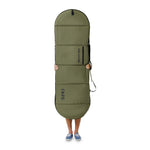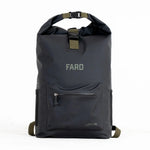Travelling with a surfboard is not the most subtle affair. Oversized and awkward to carry, a surfboard bag often draws curious glances and puzzled questions. Despite the hassle, nothing compares to the thrill of surfing perfect waves on your favorite board in an exotic location.
That said, travelling with your surf gear requires some planning to avoid damage and costly mistakes. Here’s how you can make the journey smoother and ensure your board arrives safely.
Preparing Your Surfboard for Air Travel
Air travel adds a layer of complexity to surfboard transport. Airlines are not always gentle with oversized baggage, and once you hand off your board, it’s out of your control. That’s why it’s crucial to pack smart and add some personal touches to minimise risk.
Keep Everything Secure
One of the biggest risks is internal movement inside your surfboard bag. Loose boards can shift during transit and suffer pressure dings or cracks. Once you’ve packed everything, lift the bag and shake it. If things move inside, add more padding—towels, wetsuits, or foam—to fill empty spaces.
Wrap and Reinforce
While most surfboard bags offer decent protection, zippers and corners remain vulnerable. Wrapping both ends with plastic or shrink wrap adds an extra layer of water resistance and keeps zippers secure. For added safety, reinforce the nose and tail with foam or cardboard to absorb shocks.
Personalize Your Bag
A heavy surfboard bag might seem like just another item to airline staff. A friendly message or name tag near the "fragile" sticker can humanize your luggage. A short note like “Handle with care—my surfboard means the world to me!” could encourage more mindful handling.
Step-by-Step Packing Guide
Step 1: Clean and Strip Down the Board
Begin by removing all fins, leashes, and wax. A clean board is lighter, and removing wax reduces the risk of sticky messes in heat. Place each board in a soft cover or board sock for an added layer of protection.
Step 2: Reinforce Vulnerable Areas
Use pool noodles or soft foam along the rails and edges of the board. Cut the noodles lengthwise and fit them snugly over the sides. For nose and tail protection, use towels, wetsuits, or bubble wrap. Avoid using duct tape directly on the board—it can leave residue.
Step 3: Load the Board Bag
Lay your board bag flat on the ground. If you're carrying multiple boards, place the largest board first with the rocker (the curve) facing outward. Insert dividers or towels between each board. After placing the boards, fill gaps at the nose, tail, and sides with soft materials.
Do another shake test. If there’s movement, reopen the bag and fill any remaining space. Secure all accessories—fins, wax, leash, ding repair kit—in a small pouch inside the bag.
Can You Bring a Longboard on a Plane?
Yes, most airlines accept longboards as checked oversized baggage. However, length restrictions often range between 9 and 11 feet. Always check your airline’s baggage policy before booking. Smaller regional aircraft may not have space in the cargo hold for longboards.
And to avoid surprises at the airport, it's also worth reviewing surfboard baggage fees by airline.
Essentials for Surfboard Travel
Bringing more than one board? Place each in individual day bags for added padding. These day bags are also handy for shorter trips once you reach your destination. Key items to pack include:
- Extra towels or wetsuits for padding
- A fin case to protect accessories
- Repair kits for quick fixes
- A waterproof bag for daily surf missions
Tips for a Smooth Check-In
Be Prepared and Courteous
Greet the check-in staff with a smile. Have your ID, boarding pass, and baggage payment ready. A good attitude can go a long way in getting your surfboard handled with care.
Use the Trojan Horse Method
Keep your board bag off to the side when you approach the counter. Mention casually that you have a surfboard to check. By presenting it after initial check-in, you might avoid drawing immediate attention to its size and weight.
Offer Help
Offer to carry your board bag to the oversize baggage area. Airline staff will appreciate your effort and may be more careful with your equipment.
Renting vs. Carrying Your Own
You could avoid all this by renting a surfboard at your destination. But nothing beats riding the board you're most comfortable with. If you're chasing the best waves, it's often worth the trouble of bringing your own gear.
Traveling with a surfboard isn’t always convenient—but for dedicated surfers, it’s a small price to pay for the perfect ride. With proper preparation, a quality board bag, and a thoughtful approach to packing, you can ensure your board makes it to your surf spot intact. So prep ahead, stay calm at the airport, and keep your eyes on the swell.





